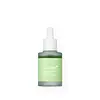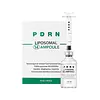What's inside
What's inside
 Key Ingredients
Key Ingredients

 Benefits
Benefits

 Ingredients Side-by-side
Ingredients Side-by-side

Centella Asiatica Leaf Water
Skin ConditioningWater
Skin ConditioningGlycerin
HumectantButylene Glycol
HumectantMethylpropanediol
SolventGlycereth-26
HumectantNiacinamide
Smoothing1,2-Hexanediol
Skin ConditioningBetaine
HumectantCarbomer
Emulsion StabilisingTromethamine
BufferingGlycereth-25 PCA Isostearate
EmulsifyingEthylhexylglycerin
Skin ConditioningDipotassium Glycyrrhizate
HumectantAllantoin
Skin ConditioningGlyceryl Acrylate/Acrylic Acid Copolymer
HumectantPanthenol
Skin ConditioningGardenia Florida Fruit Extract
Skin ConditioningCoptis Japonica Extract
AntimicrobialCentella Asiatica Root Extract
Skin ConditioningCentella Asiatica Leaf Extract
Skin ConditioningCentella Asiatica Extract
CleansingHydrogenated Lecithin
EmulsifyingMelaleuca Alternifolia Leaf Water
AntimicrobialPropanediol
SolventMadecassoside
AntioxidantGlycyrrhiza Uralensis Extract
EmollientEctoin
Skin ConditioningDipropylene Glycol
HumectantCentella Asiatica Leaf
Skin ConditioningCaprylic/Capric Triglyceride
MaskingBiosaccharide Gum-1
HumectantPentylene Glycol
Skin ConditioningMelaleuca Alternifolia Leaf Extract
PerfumingSodium Hyaluronate
HumectantVegetable Amino Acids
Skin ConditioningSaccharide Isomerate
HumectantLactobacillus Ferment Filtrate
Skin ConditioningHydrolyzed Vegetable Protein
Skin ConditioningHyaluronic Acid
HumectantHouttuynia Cordata Extract
Skin ConditioningAsiaticoside
AntioxidantMadecassic Acid
Skin ConditioningAsiatic Acid
Skin ConditioningCentella Asiatica Leaf Water, Water, Glycerin, Butylene Glycol, Methylpropanediol, Glycereth-26, Niacinamide, 1,2-Hexanediol, Betaine, Carbomer, Tromethamine, Glycereth-25 PCA Isostearate, Ethylhexylglycerin, Dipotassium Glycyrrhizate, Allantoin, Glyceryl Acrylate/Acrylic Acid Copolymer, Panthenol, Gardenia Florida Fruit Extract, Coptis Japonica Extract, Centella Asiatica Root Extract, Centella Asiatica Leaf Extract, Centella Asiatica Extract, Hydrogenated Lecithin, Melaleuca Alternifolia Leaf Water, Propanediol, Madecassoside, Glycyrrhiza Uralensis Extract, Ectoin, Dipropylene Glycol, Centella Asiatica Leaf, Caprylic/Capric Triglyceride, Biosaccharide Gum-1, Pentylene Glycol, Melaleuca Alternifolia Leaf Extract, Sodium Hyaluronate, Vegetable Amino Acids, Saccharide Isomerate, Lactobacillus Ferment Filtrate, Hydrolyzed Vegetable Protein, Hyaluronic Acid, Houttuynia Cordata Extract, Asiaticoside, Madecassic Acid, Asiatic Acid
Water
Skin ConditioningDipropylene Glycol
HumectantPropanediol
SolventGlycerin
HumectantNiacinamide
SmoothingButylene Glycol
HumectantGlycereth-25 PCA Isostearate
EmulsifyingDiethoxyethyl Succinate
SolventGlycereth-26
HumectantIsopentyldiol
HumectantPentylene Glycol
Skin ConditioningBetaine
HumectantHydrogenated Lecithin
EmulsifyingChondrus Crispus Powder
AbrasivePolyglycerin-3
HumectantBisabolol
Masking3-O-Ethyl Ascorbic Acid
Skin ConditioningSodium Dna
Skin ConditioningXylitylglucoside
HumectantAnhydroxylitol
HumectantSodium Surfactin
CleansingXylitol
HumectantGlutathione
Anastatica Hierochuntica Extract
AstringentHydrolyzed Collagen Extract
Skin ProtectingHydrolyzed Collagen
EmollientCollagen Extract
Skin ConditioningCollagen Amino Acids
MoisturisingCollagen Water
HumectantSoluble Collagen
HumectantLactobacillus/Collagen Ferment Filtrate
HumectantTromethamine
BufferingCarbomer
Emulsion StabilisingLeontopodium Alpinum Flower Extract
Skin ConditioningHouttuynia Cordata Extract
Skin ConditioningPanax Ginseng Root Extract
EmollientMorus Alba Bark Extract
Skin ConditioningBellis Perennis Flower Extract
Skin ConditioningCamellia Sinensis Leaf Extract
AntimicrobialSaussurea Involucrata Extract
HumectantLilium Candidum Flower Extract
Skin Conditioning1,2-Hexanediol
Skin ConditioningGlucose
HumectantNelumbo Nucifera Flower Extract
Skin ConditioningXanthan Gum
EmulsifyingAdenosine
Skin ConditioningDisodium EDTA
Ethylhexylglycerin
Skin ConditioningBenzyl Glycol
SolventHydroxyacetophenone
AntioxidantWater, Dipropylene Glycol, Propanediol, Glycerin, Niacinamide, Butylene Glycol, Glycereth-25 PCA Isostearate, Diethoxyethyl Succinate, Glycereth-26, Isopentyldiol, Pentylene Glycol, Betaine, Hydrogenated Lecithin, Chondrus Crispus Powder, Polyglycerin-3, Bisabolol, 3-O-Ethyl Ascorbic Acid, Sodium Dna, Xylitylglucoside, Anhydroxylitol, Sodium Surfactin, Xylitol, Glutathione, Anastatica Hierochuntica Extract, Hydrolyzed Collagen Extract, Hydrolyzed Collagen, Collagen Extract, Collagen Amino Acids, Collagen Water, Soluble Collagen, Lactobacillus/Collagen Ferment Filtrate, Tromethamine, Carbomer, Leontopodium Alpinum Flower Extract, Houttuynia Cordata Extract, Panax Ginseng Root Extract, Morus Alba Bark Extract, Bellis Perennis Flower Extract, Camellia Sinensis Leaf Extract, Saussurea Involucrata Extract, Lilium Candidum Flower Extract, 1,2-Hexanediol, Glucose, Nelumbo Nucifera Flower Extract, Xanthan Gum, Adenosine, Disodium EDTA, Ethylhexylglycerin, Benzyl Glycol, Hydroxyacetophenone
 Reviews
Reviews

Ingredients Explained
These ingredients are found in both products.
Ingredients higher up in an ingredient list are typically present in a larger amount.
1,2-Hexanediol is a synthetic liquid and another multi-functional powerhouse.
It is a:
- Humectant, drawing moisture into the skin
- Emollient, helping to soften skin
- Solvent, dispersing and stabilizing formulas
- Preservative booster, enhancing the antimicrobial activity of other preservatives
Betaine is a common humectant (a substance that promotes retention of moisture). It's known to be gentle on the skin and can help balance hydration.
This ingredient is best for improving hydration and soothing irritated skin. Studies also show it helps even out skin tone.
Fun fact: Betaine is naturally created in the skin and body. The kind found within cosmetic products can be either plant-derived or synthetic.
Another name for betaine is trimethylglycine.
Learn more about BetaineButylene Glycol (or BG) is used within cosmetic products for a few different reasons:
Overall, Butylene Glycol is a safe and well-rounded ingredient that works well with other ingredients.
Though this ingredient works well with most skin types, some people with sensitive skin may experience a reaction such as allergic rashes, closed comedones, or itchiness.
Learn more about Butylene GlycolCarbomer is a polymer of acrylic acid. Its main role is to create a gel consistency.
A high amount of carbomer can cause pilling or balling up of products. Don't worry, most products contain 1% or less of carbomer.
Dipropylene Glycol is a synthetically created humectant, stabilizer, and solvent.
This ingredient helps:
Dipropylene glycol is technically an alcohol, but it belongs to the glycol family (often considered part of the ‘good’ alcohols). This means it is hydrating and gentle on skin unlike drying solvent alcohols like denatured alcohol.
As a masking agent, Dipropylene Glycol can be used to cover the smell of other ingredients. However, it does not have a scent.
Studies show Dipropylene Glycol is considered safe to use in skincare.
Learn more about Dipropylene GlycolEthylhexylglycerin (we can't pronounce this either) is commonly used as a preservative and skin softener. It is derived from glyceryl.
You might see Ethylhexylglycerin often paired with other preservatives such as phenoxyethanol. Ethylhexylglycerin has been found to increase the effectiveness of these other preservatives.
Glycereth-25 PCA Isostearate isn't fungal acne safe.
Glycereth-26 is a synthetic ingredient and polyethylene glycol ether of Glycerin. Glycerin is already naturally found in your skin and helps keep your skin moisturized.
It is a humectant and helps add texture to products. It can make your product thicker.
As a humectant, it helps draw moisture from the air to your skin. This helps your skin stay hydrated.
Learn more about Glycereth-26Glycerin is already naturally found in your skin. It helps moisturize and protect your skin.
A study from 2016 found glycerin to be more effective as a humectant than AHAs and hyaluronic acid.
As a humectant, it helps the skin stay hydrated by pulling moisture to your skin. The low molecular weight of glycerin allows it to pull moisture into the deeper layers of your skin.
Hydrated skin improves your skin barrier; Your skin barrier helps protect against irritants and bacteria.
Glycerin has also been found to have antimicrobial and antiviral properties. Due to these properties, glycerin is often used in wound and burn treatments.
In cosmetics, glycerin is usually derived from plants such as soybean or palm. However, it can also be sourced from animals, such as tallow or animal fat.
This ingredient is organic, colorless, odorless, and non-toxic.
Glycerin is the name for this ingredient in American English. British English uses Glycerol/Glycerine.
Learn more about GlycerinHouttuynia Cordata Extract is more commonly known as Heart Leaf, Fish Mint, or Chameleon plant.
The components found in Heart Leaf give it antioxidant, hydrating, antimicrobial, and anti-inflammatory properties.
Heart Leaf is rich in flavonoids such as quercetin, apigenin, and more. It also contains polysaccharides, the most common type of carbs in food.
Flavonoids have been shown to be effective antioxidants. They help neutralize free-radical molecules. Free-radical molecules are unstable molecules that may damage our skin cells and DNA. The flavonoids in Heart Leaf also help soothe the skin.
Polysaccharides are naturally found in our skin. They play a role in hydrating and repairing the top layer of skin. The polysaccharides in Heart Leaf help moisturize our skin.
Studies show decanoyl acetaldehyde, a component of Heart Leaf oil, is effective at killing bacteria.
The name 'Fish Mint' comes from the herb's natural fishy smell. Is is native to southeast Asia and used throughout the continent for traditional cooking and medicine.
Learn more about Houttuynia Cordata ExtractHydrogenated Lecithin is created from the hydrogenation of lecithin (a group of phospholipids). Hydrogenation is a chemical reaction between hydrogen and another element.
This ingredient is an emollient and emulsifier. As an emollient, it helps soften skin by trapping moisture within. As an emulsifier, it prevents oil and water ingredients from separating.
Niacinamide is a multitasking form of vitamin B3 that strengthens the skin barrier, reduces pores and dark spots, regulates oil, and improves signs of aging.
And the best part? It's gentle and well-tolerated by most skin types, including sensitive and reactive skin.
You might have heard of "niacin flush", or the reddening of skin that causes itchiness. Niacinamide has not been found to cause this.
In very rare cases, some individuals may not be able to tolerate niacinamide at all or experience an allergic reaction to it.
If you are experiencing flaking, irritation, and dryness with this ingredient, be sure to double check all your products as this ingredient can be found in all categories of skincare.
When incorporating niacinamide into your routine, look out for concentration amounts. Typically, 5% niacinamide provides benefits such as fading dark spots. However, if you have sensitive skin, it is better to begin with a smaller concentration.
When you apply niacinamide to your skin, your body converts it into nicotinamide adenine dinucleotide (NAD). NAD is an essential coenzyme that is already found in your cells as "fuel" and powers countless biological processes.
In your skin, NAD helps repair cell damage, produce new healthy cells, support collagen production, strengthen the skin barrier, and fight environmental stressors (like UV and pollution).
Our natural NAD levels start to decline with age, leading to slower skin repair, visible aging, and a weaker skin barrier. By providing your skin niacinamide, you're recharging your skin's NAD levels. This leads to stronger, healthier, and younger looking skin.
Another name for vitamin B3 is nicotinamide. This vitamin is water-soluble and our bodies don't store it. We obtain Vitamin B3 from either food or skincare. Meat, fish, wheat, yeast, and leafy greens contain vitamin B3.
The type of niacinamide used in skincare is synthetically created.
Learn more about NiacinamidePentylene glycol is typically used within a product to thicken it. It also adds a smooth, soft, and moisturizing feel to the product. It is naturally found in plants such as sugar beets.
The hydrophilic trait of Pentylene Glycol makes it a humectant. As a humectant, Pentylene Glycol helps draw moisture from the air to your skin. This can help keep your skin hydrated.
This property also makes Pentylene Glycol a great texture enhancer. It can also help thicken or stabilize a product.
Pentylene Glycol also acts as a mild preservative and helps to keep a product microbe-free.
Some people may experience mild eye and skin irritation from Pentylene Glycol. We always recommend speaking with a professional about using this ingredient in your routine.
Pentylene Glycol has a low molecular weight and is part of the 1,2-glycol family.
Learn more about Pentylene GlycolPropanediol is an all-star ingredient. It softens, hydrates, and smooths the skin.
It’s often used to:
Propanediol is not likely to cause sensitivity and considered safe to use. It is derived from corn or petroleum with a clear color and no scent.
Learn more about PropanediolTromethamine helps balance the pH and improve the texture of a product. It is synthetically created.
As an emulsifier, Tromethamine prevents oil and water ingredients from separating. This helps stabilize the product and elongate a product's shelf life. Tromethamine also makes a product thicker.
Tromethamine helps balance the pH level of a product. Normal pH level of skin is slightly acidic (~4.75-5.5). The acidity of our skin is maintained by our glands and skin biome. Being slightly acidic allows our skin to create an "acid mantle". This acid mantle is a thin barrier that protects our skin from bacteria and contaminants.
Oral Tromethanmine is an anti-inflammatory drug but plays the role of masking, adding fragrance, and/or balancing pH in skincare.
1,3-Propanediol, 2-amino-2-(hydroxymethyl)-
Learn more about TromethamineWater. It's the most common cosmetic ingredient of all. You'll usually see it at the top of ingredient lists, meaning that it makes up the largest part of the product.
So why is it so popular? Water most often acts as a solvent - this means that it helps dissolve other ingredients into the formulation.
You'll also recognize water as that liquid we all need to stay alive. If you see this, drink a glass of water. Stay hydrated!
Learn more about Water